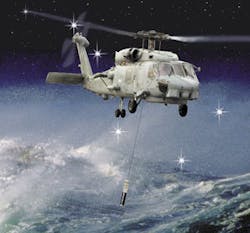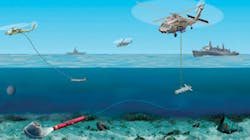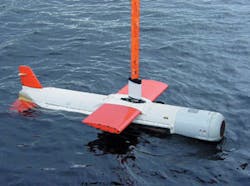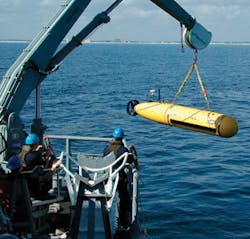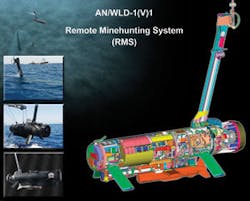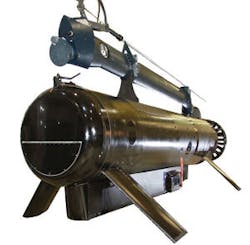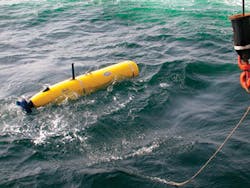The U.S. Navy prepares to deploy several new mine-detection and disposal systems that employ a wide variety of electro-optic, signal-processing, and machine-automation technologies.
By John Keller
The U.S. Navy’s ability to detect, locate, and destroy explosive mines at sea is not just a national security issue; this capability also could have profound influence on the global economy. Even a rumor of sea mines in the area can bring local maritime traffic to an immediate halt-commercial shipping, military operations, and even pleasure craft.
Today it can take more than a month for the U.S. Navy to respond with the equipment and personnel to sweep problem areas around the world where mines have been reported. Stop maritime traffic for a month in almost any region and a major economic crisis is likely to follow-the influences of which could ripple over the entire globe.
U.S. Navy experts are taking matters in hand to mitigate this potential threat by concentrating on five systems in advanced development to detect and neutralize mines quickly and efficiently, but more importantly by embedding countermine warfare equipment with traditional naval sea forces.
The Navy MH-60S helicopter, shown above, will host a variety of new mine-detection and disposal systems.
Those five systems consist of the combination of the AN/WLD-1 Remote Minehunting System (RMS) and its companion, the Remote Multi-Mission Vehicle (RMMV); the AN/AQS-20 Minehunting Sonar System; the AN/AES-1 Airborne Laser Mine Detection System (ALMDS); the AN/AWS-2 Rapid Airborne Mine Clearance System (RAMICS); and the Organic Air and Surface Influence Sweep System (OASIS).
These systems are intended to place significant minehunting capability in the hands of naval commanders in charge of carrier battle groups, surface task forces, and even of captains of individual destroyers and similar surface combatants.
“We are transitioning to what we call organic mine warfare; that means resident in the battle group,” explains Gary A. Humes, who is in charge of mine warfare inside the program executive office for littoral and mine warfare at U.S. Naval Sea Systems Command in Panama City, Fla.
Completing this transition, however, will take time. Today U.S. mine warfare capability is confined primarily to specialized units, which leaves most deployed naval forces with only minimal ability to detect and destroy mines at sea.
The nation’s counter-mine capability today resides in two aspects-14 Avenger-class mine countermeasures (MCM) vessels, as well as two squadrons of MH-53 mine-hunting helicopters based at Corpus Christi Naval Air Station, Texas, and at Norfolk Naval Air Station, Va.
Some of the helicopters are forward-deployed to spots around the world. Of the 14 existing Avenger-class mine countermeasures ships, four are forward-deployed in Bahrain, two are at Sasebo, Japan, and eight are based at Ingleside Naval Station, Texas.
“If we got called to do some mine countermeasures off the coast of South America, we would have to transport one of those MCM ships from Ingleside down to the region. That could take 30 days or more,” Humes explains.
This artist’s rendering demonstrates how the Raytheon AN/ASQ-235 Airborne Mine Neutralization System will function against tethered and bottom-placed mines. A shaped charge destroys or neutralizes the mine.
“Mine warfare is analogous to a bomb threat at a school,” he continues. “You secure everything, bring in the bomb squad, search every locker and hallway, and either find and dispose of the bomb, or declare an all-clear if no bomb is present. That is similar to a mine threat; you don’t need to have the presence of a mine; you just need the threat, and that could stop seagoing shipping, military activities, and even pleasure craft until you find the mines or declare an all-clear. You are all-stop for at least 30 days.”
The economic fallout from such a halt in maritime traffic could be immense. The military implications also would be serious. “If we have a carrier battle group trying to get through the Suez Canal or the Straits of Hormuz and those areas were mined, the carrier battle group would have to call on these mine assets, and that takes time,” Humes says.
In the near future, Navy leaders want to reduce the time it takes to get mine-hunting equipment on the scene by at least two thirds. Ultimately the plan is to get sufficient counter-mine capability out to the fleet so that deployed forces can carry out mine detection and disposal operations without breaking stride.
In addition, Navy officials want the ability to sweep for mines without putting humans or manned vessels at risk. “We want to reduce the time line, and get the man out of the minefield,” Humes explains. “The two primary technologies that have enabled us to do that are unmanned vehicles and autonomous operations.”
Remote Minehunting System
One of the first lines of defense against sea mines is the AN/WLD-1 Remote Minehunting System (RMS)-a 23-foot-long semiautonomous, semisubmersible vehicle that locates and classifies mines. The system’s manufacturer is the Lockheed Martin Undersea Systems division in Riviera Beach, Fla.
The RMS-essentially a small diesel-powered submarine with a snorkel and antenna mast-can function under control of a human operator or autonomously. The vehicle’s mast, which always protrudes from the water, gives the vessel over-the-horizon and line-of-sight radio communications, and continuous Global Positioning System navigation.
“We have seven systems in low-rate initial production, and are completing operational evaluation,” Humes says of the RMS. The system is scheduled to deploy for the first time this fall aboard the Burke-class destroyer USS Bainbridge (DDG 96). The future Littoral Combat Ship (LCS) will have the RMS as part of its standard equipment.
The RMS mission is to detect and pinpoint mines in the water so other systems can come back and destroy them later, or to enable Navy commanders to alter their missions to avoid mine fields.
The RMS has an onboard camera, which helps the vehicle navigate and avoid obstacles, and its primary sensor payload is the Raytheon AN/AQS-20 Minehunting Sonar System, which the AN/WLD-1 tows behind it at variable depths to locate mines.
An antisubmarine-warfare version of the RMS is called the Remote Multi-mission Vehicle (RMMV), also built by Lockheed Martin, which tows the AN/AQS-20. This variant searches for hostile submarines rather than for sea mines. Navy leaders have 11 of these systems on order, and are seeking permission to build nine additional systems, Humes says.
Minehunting Sonar System
The AN/AQS-20 is a towed body that can work either with the RMS, Navy surface ships, or with the Navy MH-53 and MH-60S helicopters. It has five sonars-two side-scan sonars, a gap filler sonar, a forward-looking sonar, and a volume search sonar. The system also has an electro-optic identification (EOID) capability that yields high-definition images of bottom mines using streak-tube imaging LIDAR, otherwise known as STIL technology. “It won’t quite get you 360 degrees of coverage, but it might get you 270 degrees coverage, or more,” Humes says.
The AQS-20 is designed to detect mines in relatively deep water-at least 40 feet below the surface and extending “down to where mines are not effective any more,” Humes says. Its maximum effective depth is classified. The system is especially effective at single-pass detection and classification of volume and bottom mines. Its builder is Raytheon Integrated Defense Systems in Portsmouth, R.I.
The AQS-20 uses imaging sonars, signal processing, and computer algorithms to localize mine-like objects and alert the system operator with a visual image and a contact data list. It is 10.5 feet long, 15.5 inches in diameter, and weighs 975 pounds.
The system sends sonar and imaging data up its fiber-optic tow cable to the operator console located either aboard the host helicopter or surface ship, or by wireless data links to operators aboard nearby surface vessels if it is operating with the RMS or other unmanned vehicles. The operator’s station has a high-speed data recorder to store mission information for later analysis.
Airborne Mine Neutralization System
Once the RMS, the AQS-20, or other sensors detect mines, Navy commanders must destroy them or render them harmless. They can do this with the AN/ASQ-235 Airborne Mine Neutralization System (AMNS) from Raytheon Integrated Defense Systems.
The ASQ-235 AMNS uses the same vehicle as the AQS-20 Minehunting Sonar System. It deploys and is towed from MH-60S helicopter, which uses its own sonar and camera, and takes data from other counter-mine sensors to pinpoint the locations of mines The system then destroys mines with one of the four tethered expendable munitions attached to the vehicle.
The Raytheon AN/AQS-20 Minehunting Sonar System, shown above, is the primary minehunting sensor system for the MH-60S helicopter, as well as the AN/WLD-1 Remote Minehunting System.
Ultimately Navy experts seek to untether the AMNS, and enable it to swim out on its own into the mine danger area. The system’s tethered neutralizers are on optical fiber, which enables the system to make a pass, detect and classify any mines, and deploy the neutralizer munition, which has a shaped charge in its nose. Essentially it swims up to the mine, puts its nose against it, and detonates itself, destroying the mine.
The ASQ-235 system consists of a control console and a launching mechanism for its four unmanned underwater vehicles, which are tethered to the primary ASQ-235 vehicle with fiber-optic cable and equipped with video and sonar sensors to detect and pinpoint anti-shipping mines.
Shallow-water threats
Littoral ocean areas along coasts and inside harbors and coves are some of the most difficult areas in the world in which to operate sonar. Sound waves can bounce crazily off rocks, the sea bottom, shipwrecks and other debris, sea life, and commercial ship traffic, creating a sonic din from which it is difficult to isolate signals of interest.
In addition, the shallow water itself can render sonar almost useless. “Sonar is not very effective in shallow waters,” Humes explains. Sonar performance drops off sharply in waters between the surface and 40 feet in depth, which could render surface shipping particularly vulnerable to sea mines lurking in this region of the water column.
It is precisely this 40-foot gap in the water column that the Navy’s AN/AES-1 Airborne Laser Mine Detection System (ALMDS) is designed to cover. The ALMDS is a light detection and ranging (LIDAR) imaging airborne mine countermeasures high area coverage system that detects, classifies, and localizes floating and near-surface moored sea mines.
Developing and manufacturing the ALMDS are engineers at the Northrop Grumman Corp. Airborne Ground Surveillance and Battle Management Systems segment in Melbourne, Fla. The ALMDS is packaged in a pod that mounts to the side of the MH-60S helicopter. It projects a pulsed wide 538-nanometer blue-green laser beam into the water and samples at rates greater than 100 per second. This wavelength of blue-green laser “can penetrate water much better than other wavelengths. It goes a long way down,” says John Horton, head of the mine warfare systems department at the U.S. Naval Surface Warfare Center in Panama City, Fla.
“With the ALMDS and the AQS-20, we can detect mines across the entire water column,” Humes explains. “When sonar starts to be ineffective, that is the gap that the ALMDS will cover. The Navy has not had any capability in that shallow water column today.”
Northrop Grumman has delivered two sets of ALMDS equipment, which are under evaluation. The system is scheduled for deployment aboard the future Littoral Combat Ship, and delivery of the first mine warfare package for this ship is set for September of this year. The ALMDS, however, could be used almost anywhere from which a Navy MH-60S helicopter could operate.
Rapid Airborne Mine Clearance System
Once the ALMDS or another system detects shallow mines, Navy leaders can send in the AN/AWS-2 Rapid Airborne Mine Clearance System (RAMICS) to dispose of them. Like the ALMDS, the RAMICS uses blue-green laser technology, yet rather than using a wide laser beam to detect mines as the ALMDS does, the RAMICS uses a spot laser to pinpoint already discovered mines for destruction.
Developing and manufacturing RAMICS is the Northrop Grumman Corp. Integrated Systems Airborne Ground Surveillance and Battle Management Systems, which also builds the ALMDS.
The RAMICS-equipped MH-60S helicopter flies to the known mined area using satellite Global Positioning System (GPS) coordinates it has received from the ALMDS or other detection systems, and acquires the mine with the spot laser. The system’s targeting pod translates the angle to target. Then a Mark 30 Bushmaster machine gun with special bullets destroys the mine. The stabilized gun usually fires a burst of between 20 and 50 projectiles, which have a shape and speed to produce a cavitation envelope in which the projectile rides at very low drag.
“We have developed a super-cavitating round that enters water with such velocity that it creates an air bubble that allows the round to travel in a straight line through the water,” Humes says. “It can travel far through the water, and can cause significant damage at significant depths.” The ASQ-235 projectile strikes the mine at a velocity sufficient to penetrate the mine and release a reactive material into the explosive to detonate and destroy it.
Organic Air and Surface Influence Sweep System
Mine-hunting systems like the ALMDS and RAMICS are more than sufficient in areas where the water is clear enough for lasers to operate, but sometimes Navy commanders encounter mined areas where the water is so murky that electro-optical sensors like LIDAR and even visible-light cameras are not effective. “You hunt when you can, and sweep when you must,” Humes says.
Where the sea water is too cloudy to see, Navy leaders can call in the Organic Air and Surface Influence Sweep System, otherwise known as OASIS. “In difficult detection environments where mines are unhuntable, you have to sweep,” Humes explains.
OASIS, built by EDO Defense Systems in North Amityville, N.Y., is towed from an MH-60S helicopter. When other sensors detect the presence of mines, the OASIS system can trigger the mines at a safe distance by emitting an electromagnetic and acoustic signature with a cavitating impeller on each side of the system’s towed body.
Essentially OASIS confuses the mine by falsely indicating the presence of a ship nearby. It approaches the minefield from the edges, then cuts in to detonate the mines far enough away so that it does not damage the OASIS equipment. This is a large system, and is too big for the SH-60S helicopter. The only aircraft large enough to tow it is the MH-53 helicopter.
OASIS has six major components: the towed body, the magnetic influence subsystem, the acoustic influence subsystem, the control/monitoring and power subsystem, the common console OASIS software, and the tow cable interface.
The towed body is hydrodynamically stable in all control modes while being towed in a straight course and while making turns. The towed body measures its tow depth and its height above the bottom, and uses this data to find the best depth for minesweeping. The tow cable distributes power, and communicates with the aircraft.
The towed body moves along in a bottom-following mode; a transducer helps the system to hug the bottom. The system receives power from the helicopter, which flows to different transformers in the system from two electrodes, and makes a magnetic field in the water.
Minehunting research
Other mine-detection systems are in experimental development. Among those is the Battlespace Prep Autonomous Underwater Vehicle (BPAUV) from Bluefin Robotics Corp. in Cambridge, Mass. This autonomous underwater vehicle is lowered into the water by shipboard crane, and covertly gathers bathymetry to map the ocean bottom near shore to detect physical changes that might indicate the presence of hostile anti-shipping mines.
The fully autonomous robot submarine can operate on its own or with the help of an operator when the vehicle is on the surface, using the Iridium satellite communications system. It has onboard dead-reckoning systems, an inertial measurement unit, and a Doppler velocity sonar sensor log to measure its speed over the bottom.
The BPAUV has a side-scan sonar system that projects sound out to the sides of the vehicle, and detects objects as large as 150 meters along either side of the vehicle. The system is designed for deployments as long as 15 hours on power from lithium polymer batteries, which are environmentally enclosed and rechargeable.
Bluefin also is developing the Hovering Autonomous Underwater Vehicle (HAUV) to detect and disarm explosive mines found to be attached to the hulls of ships. Bluefin won a $161.7 million contract in May to demonstrate the HAUV for U.S. Naval Sea Systems Command. The demonstration is set for this month at Space and Naval Warfare Systems Center in San Diego.
The prototype HAUV can operate autonomously to inspect ship hulls using a Doppler velocity log, inertial measurement unit, compass, satellite Global Positioning System, and high-resolution imaging sonar. Lithium-polymer batteries power the vehicle.
Bluefin will demonstrate the HAUV’s ability to detect and classify targets, but specifically to perform pre-mission set-up, launch, search, recovery, and post-mission Analysis.
The next step in mine-hunting technology development
U.S. Navy researchers are ready to deploy autonomous and semiautonomous marine vehicles that are able to search for, detect, and even destroy explosive mines hidden in the ocean’s depths.
Now they are looking at innovative ways to boost the efficiency of the data bandwidth they can use, improve signal processing, enhance electro-optical sensor technology, and to take the next step in counter-mine warfare technologies.
New systems on the verge of deployment will reduce by two-thirds the time it takes to bring mine-hunting systems on station once mines are detected, “but we need to do better than that,” says Gary A. Humes, who is in charge of mine warfare inside the program executive office for littoral and mine warfare of U.S. Naval Sea Systems Command under PEO Littoral and Mine Warfare at the U.S. Naval Surface Warfare Center in Panama City, Fla.
“We need multiple autonomous vehicle control,” Humes says. “Bandwidth now is our limiting factor, so we need to do much more front-end processing.” Humes and his colleagues are searching for ways to accomplish most signal processing either aboard autonomous vehicles, or aboard the aircraft that control them, rather than on ships after the search has ended.
Better front-end signal processing could lead to a new ability for mine-hunting autonomous vehicles not only to make intelligent deductions about what they find in suspected mine fields, but also to share those conclusions with other autonomous vehicles operating in the area, or with human operators in real time aboard aircraft and surface ships.
One goal of current research is to make mine detection completely autonomous. “Right now we have computer-aided detection and classification, with an operator in the loop. We are coming up with new detection algorithms to get to where computer-aided simply becomes computer detection,” says John Horton, head of the mine warfare systems department at the U.S. Naval Surface Warfare Center in Panama City, Fla.
Mine-hunting systems today have limited ability to process the heavy load of data they receive from on-board sensor systems. Most of the processing happens either aboard aircraft or aboard surface ships that receive the vehicle sensor data on overburdened RF data links.
“If we can do all the processing inside the towed system or autonomous vehicle, then the data I have to send is very small-simply the mine location and depth, or a sonar picture of the object,” Horton says. “We want to make more efficient use of existing bandwidth.”
Two research projects with this goal in mind involve high-frequency wideband sonar, and low-frequency broadband sonar. High-frequency sonar increases the amount of data available from the sonar signal returns-in essence, a more sensitive sonar. “Mines are getting smaller and harder to see, that is the trend,” Horton says.
This technology is probably two to five years away from deployment. Its first use most likely will be on the dedicated Avenger-class mine countermeasures ships, Horton says.
Low-frequency sonar, on the other hand, can yield a color acoustic picture able to discern quickly between manmade and natural objects. This technology most likely is more than five years away from deployment.
The digital signal processing technology available on the commercial market, at least for now, is sufficient for autonomous mine hunting. “The speed of the processors in the commercial market seems to be adequate for us,” Horton says. “I can use every bit of speed the commercial market gives me.”
Other technologies are emerging to enhance electro-optical sensors used in mine detection. “What made the ALMDS (the N/AES-1 Airborne Laser Mine Detection System, see above) was the streak tube, which is used to gather data fast,” Horton says. Other cameras are evolving called 3D cameras that will change the way that is done. Once the 3D cameras get further along, we can take out that streak tube.”
